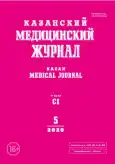Нейроиммунные предикторы исхода аневризматического субарахноидального кровоизлияния
- Авторы: Ермаков С.В.1, Карпов С.М.2, Батурин В.А.2, Белоконь О.С.1, Можейко Р.А.1,2
-
Учреждения:
- Ставропольская краевая клиническая больница
- Ставропольский государственный медицинский университет
- Выпуск: Том 101, № 5 (2020)
- Страницы: 754-759
- Раздел: Обмен клиническим опытом
- Статья получена: 11.06.2020
- Статья одобрена: 18.09.2020
- Статья опубликована: 27.10.2020
- URL: https://kazanmedjournal.ru/kazanmedj/article/view/34735
- DOI: https://doi.org/10.17816/KMJ2020-754
- ID: 34735
Цитировать
Аннотация
Цель. Установление возможности прогнозирования течения и исходов субарахноидального кровоизлияния с использованием определения уровня аутоантител к нейроспецифическим белкам.
Методы. Проведено определение аутоантител к нейроспецифическим белкам у 65 человек: 35 пациентов с установленным клинически и подтверждённым инструментально диагнозом «субарахноидальное кровоизлияние», а также у 30 здоровых добровольцев. Методом иммуноферментного анализа произведено определение в плазме крови пациентов аутоантител к основному белку миелина, периферическому миелину, дофаминовым рецепторам, миозину, N-метил-D-аспартат-рецепторам, белку S100. У всех пациентов определяли тяжесть субарахноидального кровоизлияния в динамике, для чего были использованы следующие шкалы: Hunt–Hess, модифицированная шкала Рэнкина, Graeb и др. Статистический анализ выполнен в программе Statistica 13.0 с последовательным использованием методов описательной статистики, критериев Манна–Уитни, Краскела–Уоллиса, Пирсона, коэффициента Спирмена.
Результаты. На первом этапе исследования определены нейроспецифические белки, характеризующиеся большим приростом уровня аутоантител. Далее в ходе анализа полученных данных установлена статистически значимая корреляционная взаимосвязь между средним значением уровня аутоантител к белку S100 (360,43±40,35 мкг/мл, p <0,05), основному белку миелина (145,91±12,43 мкг/мл, p <0,05), N-метил-D-аспартат-рецепторам (66,17±6,42 мкг/мл, p <0,05) и исходом аневризматического субарахноидального кровоизлияния.
Вывод. В ходе исследования установлено нарастание уровня аутоантител к нейроспецифическим белкам в плазме крови пациентов, зависящее от тяжести субарахноидального кровоизлияния и развития отсроченных ишемических изменений вследствие церебрального ангиоспазма; высокие показатели уровня аутоантител к белку S100 при субарахноидальном кровоизлиянии связаны с церебральным ангиоспазмом и развитием вторичных (отсроченных) ишемических изменений головного мозга.
Полный текст
Об авторах
Сергей Васильевич Ермаков
Ставропольская краевая клиническая больница
Автор, ответственный за переписку.
Email: s.v.yermakov@yandex.ru
Россия, г. Ставрополь, Россия
Сергей Михайлович Карпов
Ставропольский государственный медицинский университет
Email: s.v.yermakov@yandex.ru
Россия, г. Ставрополь, Россия
Владимир Александрович Батурин
Ставропольский государственный медицинский университет
Email: s.v.yermakov@yandex.ru
Россия, г. Ставрополь, Россия
Олег Сергеевич Белоконь
Ставропольская краевая клиническая больница
Email: s.v.yermakov@yandex.ru
Россия, г. Ставрополь, Россия
Ростислав Александрович Можейко
Ставропольская краевая клиническая больница; Ставропольский государственный медицинский университет
Email: s.v.yermakov@yandex.ru
Россия, г. Ставрополь, Россия; г. Ставрополь, Россия
Список литературы
- Головина Н.П., Лавров Ю.В., Куташов В.А., Сазонов И.Э. Церебральный инсульт: современный взгляд на проблему. Прикладные информационные аспекты медицины. 2015; 18 (5): 56–62.
- Батурин В.А., Батурина М.В., Мамцева Г.И., Боев О.И. и др. Изучение уровней нейротропных аутоантител у больных шизофренией. Мед. вестн. Северного Кавказа. 2016; 11 (2): 176–178. doi: 10.14300/mnnc.2016.11030.
- D’Souza S. Aneurysmal subarachnoid hemorrhage. Neurosurg. Anesth. 2015; 27 (3): 22–40. doi: 10.1097/ANA.0000000000000130.
- Kerz T., Boor S., Ulrich A. et al. Endovascular therapy for vasospasm after aneurysmatic subarachnoid hemorrhage. Brit. J. Neurosurg. 2016; 30 (5): 49–53. doi: 10.3109/02688697.2016.1173193.
- Becker K. Modulation of the postischemic immune response to improve stroke outcome. Stroke. 2010; 41: 75–78. doi: 10.1161/STROKEAHA.110.592881.
- Sanchez-Pena P., Pereira A.-R., Sourour N.-A. et al. S100B as an additional prognostic marker in subarachnoid aneurysmal hemorrhage. Crit. Care Med. 2008; 36 (8): 2267–2273. doi: 10.1097/CCM.0b013e3181809750.
- Белоконь О.С., Ермаков С.В., Карпов С.М. и др. К вопросу о выборе метода хирургического лечения церебрального ангиоспазма у пациентов с аневризматическим субарахноидальным кровоизлиянием. Мед. вестн. Северного Кавказа. 2020; 15 (1): 119–120. doi: 10.14300/mnnc.2020.15028.
- Hop J.W., Rinkel G.J., Algra A. et al. Case-fatality rates and functional outcome after subarachnoid hemorrhage: A systematic re-view. Stroke. 1997; 28: 660–664. doi: 10.1161/01.str.28.3.660.
- Yong-Ke Zheng, Xiao-Qiao Dong, Quan Du. Comparison of plasma copeptin and multiple biomarkers for assessing prognosis of patients with aneurysmal subarachnoid hemorrhage. Clin. Chim. Acta. 2017; 465: 64–69. doi: 10.1016/j.cca.2017.10.009.
- Айвазян В.А., Бояджян В.С., Манукян Л.А. и др. Компоненты системы комплемента С3 и фактор В в крови больных с острым ишемическим инсультом. Ж. неврол. и психиатрии им. С.С. Корсакова. Прил. Инсульт. 2005; (15): 57–60.
- Amantea D., Nappi G., Bernardi G. et al. Post-ischemic brain damage: pathophysiology and role of inflammatory mediators. FEBS J. 2009; 276 (1): 13–26. doi: 10.1111/j.1742-4658.2008.06766.x.
Дополнительные файлы












